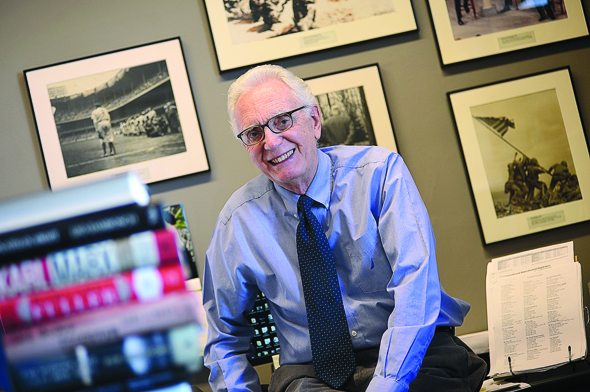
When Sig Gissler announced in January that he would step down as administrator of the Pulitzer Prizes after 12 years, he received notes from his former students all over the world–journalists working in Beirut, Cairo, and South Sudan. During his 20 years at Columbia University’s Graduate School of Journalism, first as a professor and later as administrator, he built an extended family of journalists, evidenced by the photographs of students’ children hanging on his office door. Gissler began his own career in journalism almost 60 years ago. A fascination with newspapers and a need for a job after his first child was born led a 19-year-old Gissler to a newspaper reporting job where he made $40 a week. Over the next six decades, his work brought him to more than 50 countries, where he saw “the whole range of human experience,” he says. As editor of The Milwaukee Journal from 1985 to 1993, he focused much of his energy on increasing newsroom diversity and improving coverage of racial issues. Gissler spoke with CJR’s Nicola Pring to reflect on his career in journalism, of which he said, “It’s hard to find a better way to lead your life.”
How has digital journalism changed the Pulitzer Prizes? When I became administrator in 2002, our submissions were on paper. We’d have over 1,000 scrapbooks that would be submitted. We used to joke that FedEx was circling the building to drop off all these scrapbooks. We did two things that were quite important. One was we created a future committee to look into the future of the Pulitzer Prizes, and out of that came the decision to begin to allow online content from newspapers. Then we took the next step and allowed online-only organizations to submit material. In many ways, we’ve entered the golden age of journalism, where the storytelling capabilities and techniques are greater than ever. The ability to tell stories not only in text but also with video, interactive graphics, and all the other tools and techniques that are available is marvelous.
What does it take to produce Pulitzer-worthy journalism? I think prizes are generally marked by excellent, deep-digging reporting and very compelling writing, and increasingly, they involve the enhancement of the story with digital tools. I’ve often said that some of the best stories are out there just waiting to be discovered, and sometimes it’s just a matter of luck. One of them was The Sun Sentinel in Florida. They exposed the way police officers were driving at recklessly high speeds, sometimes up to 130 miles an hour. The Sun Sentinel went out and got data and measured how long it takes to get from one point to another point on a toll road, and they were able to document who was speeding at these reckless rates. To me, that was a perfect example of the stories that are just out there waiting to be done.
You’ve studied media coverage of racial and ethnic issues extensively. What fueled your interest in the subject? How has coverage changed? I’ve called race issues “America’s rawest nerve.” They define us, they divide us, they distort us as a society. This whole field has just become more and more challenging and complex because of the changing face of America. [Coverage] tends to be episodic. All of a sudden we’ll do a series about some racial issue, but we don’t always stand back and provide enough context, enough history. But over the years I’ve seen improvement, which I find encouraging.
You also taught courses at the Journalism School on covering race. The race seminar was always interesting. Students would go out and find all kinds of fascinating stories that took coverage in a very fresh and meaningful direction. I enjoyed that course because the issues were very complicated, sometimes very emotional. Sometimes classes ended in tears because it could get very personal.
What’s next for you? I love this school. Some of my most gratifying days on earth occurred within the walls of this building, so I would like to keep my hand in, and maybe coach some master’s projects, maybe even co-teach a course without getting too deeply engaged in it.
Nicola Pring is a CJR intern
